You trace the evolution of OPM from the emotionally rich Kundiman to the vibrant sounds of contemporary pop. Kundiman, with its traditional structure and themes of love and nationalism, emerged in the late 19th century. By the 1970s and 1980s, American rock, R&B, and disco influenced OPM, leading to the rise of Manila Sound and the blending of Western pop with Filipino lyrics. The 1990s saw Pinoy Rock and hip hop emerge, reflecting cultural identity through diverse genres. Today, Pinoy Pop with high production values and influences from K-pop and EDM continues to evolve. Exploring further, you can uncover more about the cultural fusion and the ongoing impact of independent artists on the genre.
Definition of Kundiman
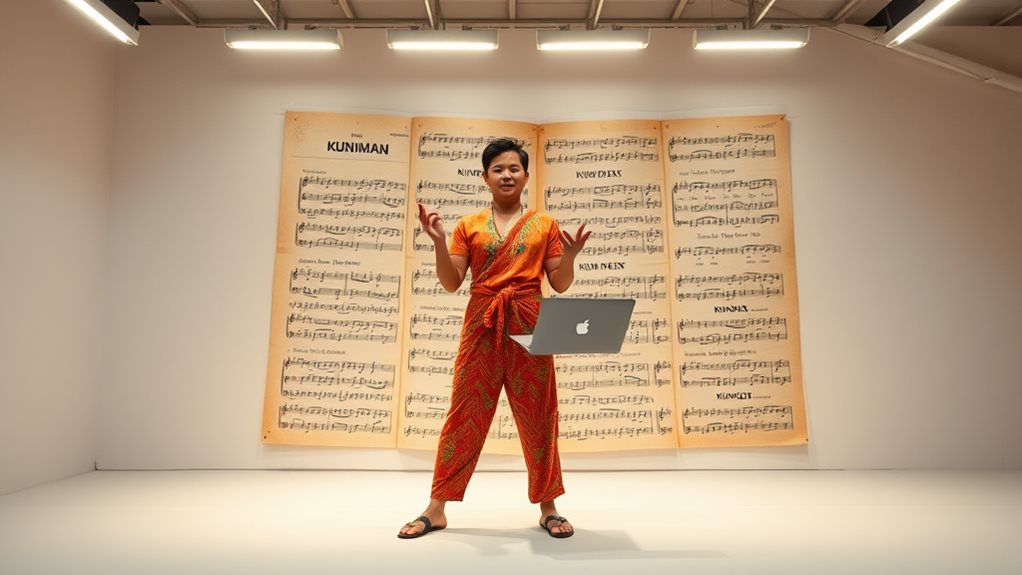
Although the term "kundiman" translates to "My Country," this traditional Filipino love song is more than just a patriotic expression; it's a deeply emotional and lyrically rich genre that also conveys personal love, reflecting themes of affection for both romantic partners and one's homeland.
Emerging in the late 19th century, kundiman became a significant part of Filipino music, blending Western musical traditions and local folk elements to serve as a form of resistance against colonial rule. Notable composers like Francisco Santiago and Nicanor Abelardo contributed to its development and popularization, integrating modern influences while preserving the genre's traditional soul.
These musicians recognized the power of the kundiman to unite Filipinos through its emotional resonances and culturally rooted lyrics, transforming it into a beloved expression within the broader spectrum of Filipino music.
Kundiman Structure
In a kundiman, you encounter a three-part structure that begins with an introduction, followed by a fan usage section, and culminates in a love declaration, enabling a clear emotional progression through the narrative. This structure is hallmark of the music culture in the Philippines, allowing kundiman, love songs, to express deep emotions to their audience. The ¾ time signature typically starts in a minor key, evoking a sense of longing and sentimentality. Lyrical melodies are smooth and flowing, utilizing traditional Filipino scales and rhythms that enhance the emotional impact. Accompaniment by piano or small ensembles supports the vocal lines, contributing to the overall emotional depth of the performance.
| Part of Structure | Purpose |
|---|---|
| Introduction | Sets the scene, minor key for sentiment |
| Fan Usage Section | Builds anticipation, traditional rhythms |
| Love Declaration | Climax of emotion, love confession |
| Outro | Resolves emotions, returns to calmness |
Kundiman Themes

Exploring beyond the structure of kundiman reveals a rich tapestry of themes that resonate deeply within the Filipino experience. In kundiman, love for a romantic partner and for the country, encapsulating Filipino nationalism, emerges as a central motif.
These songs are replete with emotional expressions, painting a vivid picture of heartache, longing, and devotion that align with Filipino cultural values. Historically, kundiman served as a poignant form of resistance against colonial rule, subtly infused with patriotism in its lyrical content.
The intimate and often melancholic portrayal of love in kundiman isn't merely fleeting but deeply intertwined with a broader sense of national pride. Through the smooth, flowing melodies and traditional Filipino scales, kundiman expresses both personal and communal emotions, creating a powerful connection with listeners' hearts and minds.
This dual focus on love and nationalism showcases the intricate emotional expressions within kundiman, highlighting its significance in OPM.
Kundiman Origins
Originating in the late 19th century during the Philippine Revolution, kundiman emerged as a form of resistance against colonial rule while simultaneously expressing deep emotional and nationalistic sentiments.
The term "kundiman" translates to "My Country," reflecting its dual themes of love for both the homeland and romantic partners, often intertwined in its lyrical content.
Characterized by a ¾ time signature and typically starting in a minor key, kundiman features smooth, flowing melodies accompanied by piano or small ensembles to enhance its emotional depth.
Key figures like Francisco Santiago and Nicanor Abelardo were instrumental in the development of kundiman, integrating Western musical traditions with Filipino folk elements.
- Emphasized the use of minor keys and melodic grace, adding emotional resonance
- Incorporated Western harmonies into traditional Filipino folk melodies
- Often performed to uplift spirits and foster a sense of national pride
- Most frequently featured lyrics of longing for lost loves and the country
Kundiman Evolution
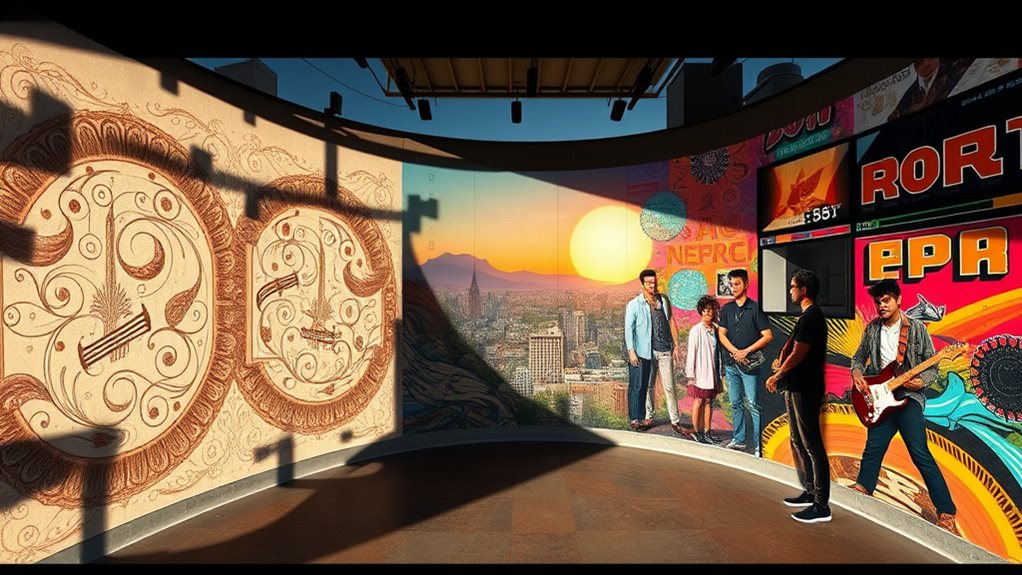
A kundiman's journey through time has seen its musical structure and themes evolve, adapting to contemporary tastes while preserving its rich cultural heritage.
Emerging in the late 19th century during the Philippine Revolution, kundiman blended Western musical traditions with Filipino folk elements. With its typical three-section format and ¾ time signature starting in minor keys, kundiman conveyed resistance against colonial rule and later reflected themes of love and nationalism through compositions by pivotal figures like Francisco Santiago and Nicanor Abelardo.
Over time, the genre integrated modern influences into its traditional roots, seeing revival efforts in the late 20th century to maintain its cultural importance.
Through these changes, kundiman retained its lyrical melodies and traditional scales, articulating profound themes of love and patriotism that deeply resonate with Filipino values and emotions.
Cultural Identity Impact
Drawing on the rich tapestry of traditional kundiman, OPM evolved to embody themes of love for the country and personal relationships, deeply rooted in Filipino cultural values and heritage.
This evolution allowed OPM to become a significant carrier of cultural identity, blending Western pop influences with Filipino lyrics to create a sound distinctly your own.
During the 1970s and 80s, OPM artists began to tackle societal issues and personal sentiments, strengthening the genre's link to Filipino identity. Your musicians often incorporated indigenous musical elements and themes, fostering pride in traditional Filipino culture while appealing to modern tastes.
The nostalgic quality of these songs evokes shared memories among Filipinos, creating a collective identity that spans generations and underscores the importance of music in your social life.
- Crafting lyrics that resonate with Filipino cultural values
- Integrating Western pop with indigenous folk music
- Addressing societal issues and personal sentiments to reinforce identity
- Utilizing traditional musical elements to foster a sense of pride
Colonial Influence Analysis
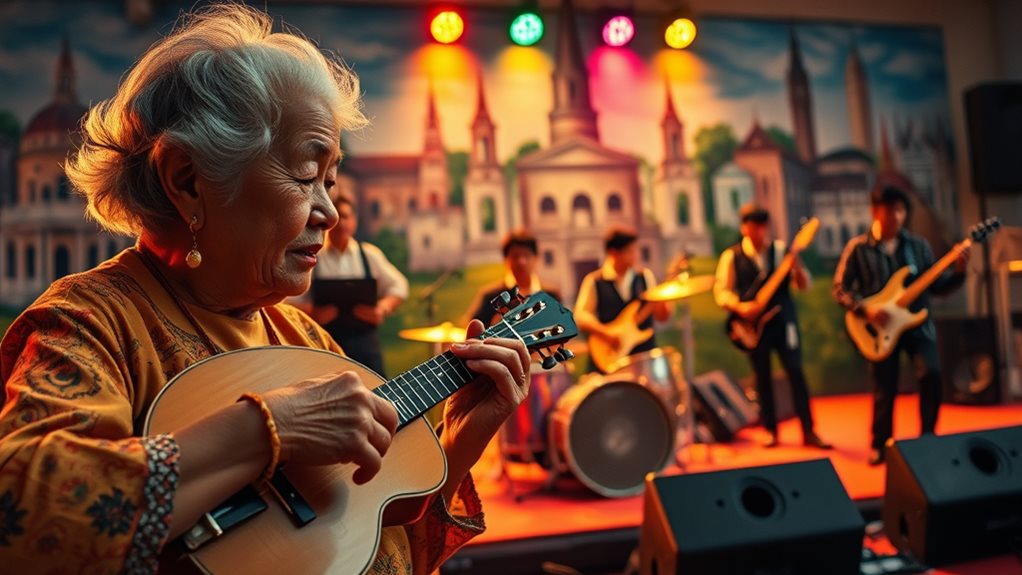
The evolution of Original Pilipino Music reflects the profound interplay between colonial rule and native musical traditions, with Spanish and American influences merging to transform and enrich the Filipino sonic landscape, integrating folk elements with Western styles to forge a unique cultural identity.
Analyzing the colonial influence on OPM, one observes how the kundiman, a traditional Filipino love song emerging in the late 19th century, blends indigenous melodies with Western musical structures. This form not only expresses deep emotional sentiments but also serves as a form of resistance against colonial oppression.
During Spanish colonization, the introduction of Catholic themes led to the incorporation of religious motifs in Filipino music, influencing the development of choral and zarzuela genres, where both sacred and secular compositions coexist, demonstrating a complex synthesis of cultures.
By the American colonial period, exposure to Western pop and rock further altered the musical landscape. These influences laid the groundwork for later developments in the Manila sound, though the latter will be discussed separately.
The revival of traditional forms like the kundiman in contemporary OPM highlights a nostalgic return to cultural roots, while also adapting to modern musical trends, showcasing the ongoing dialogue between past and present in Filipino music.
Manila Sound Influence
Manila Sound emerged in the 1970s, blending Western pop music with Filipino lyrics to create catchy melodies and danceable rhythms, significantly influencing the evolution of Original Pilipino Music (OPM).
This genre popularized by artists like VST & Company and the Apo Hiking Society introduced disco and funk elements, making OPM more mainstream.
The Manila Sound reflected cultural shifts and aspirations, diverging from the kundiman's sentimental themes to focus on youth, love, and social issues.
This fusion helped establish a sense of national identity through music, laying foundations for diverse genres in contemporary Filipino music.
- Key artists like VST & Company and the Apo Hiking Society popularized disco and funk elements
- Manuel Tobias of the Apo Hiking Society brought new themes like youth and social issues to OPM
- The Manila Sound served as a bridge between kundiman and contemporary pop styles
- This influence led to the development of Pinoy rock and pop, enriching the Filipino music landscape
OPM in Different Languages
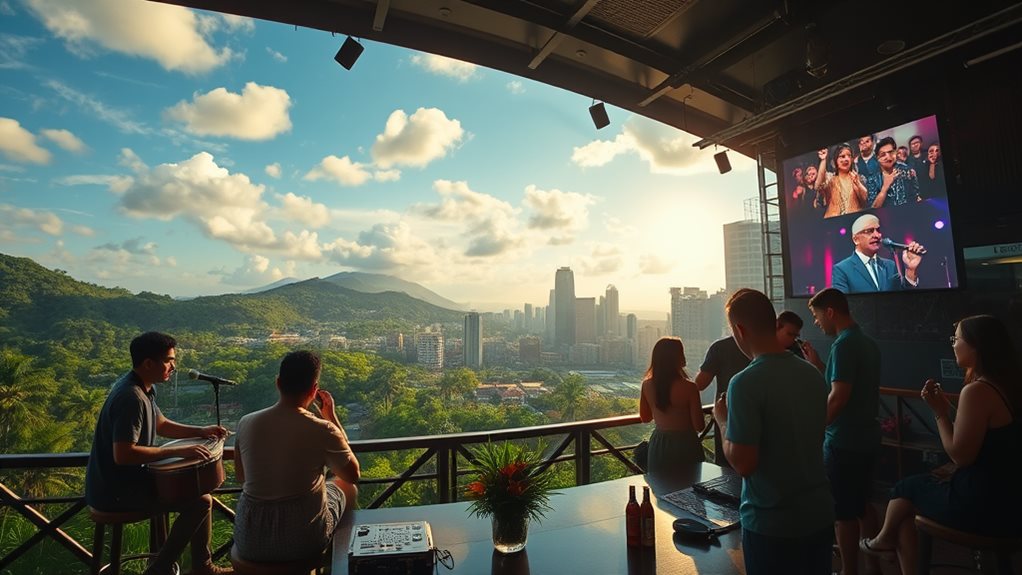
Several original Pilipino music (OPM) compositions feature songs in a multitude of Philippine languages beyond Tagalog, showcasing the country's linguistic richness.
You find artists incorporating Cebuano, Ilocano, and Hiligaynon into their OPM, reflecting the nation's diverse linguistic tapestry.
English and Taglish also play significant roles, particularly in contemporary pop and rock songs, appealing to younger audiences and the global Filipino diaspora.
By mixing Tagalog with English, songs like "Tadhana" by Up Dharma Down enhance relatability and emotional connection.
The evolution of OPM leads to multilingual compositions, with artists such as Ben&Ben blending Filipino languages with English lyrics to reach broader audiences.
This incorporation not only enriches the musical landscape but also serves as a cultural bridge, allowing for the expression of diverse Filipino experiences and identities.
Pinoy Pop Overview
In branching out from traditional Filipino pop, Pinoy Pop (P-pop) emerged in the 2010s as a vibrant revival, characterized by high production quality and a diverse array of musical styles that draw from K-pop, J-pop, and EDM influences. Notable P-pop artists include Regine Velasquez, Sarah Geronimo, and SB19, who've garnered both national and international recognition, contributing to the genre's growing popularity.
The resurgence of Pinoy Pop coincided with the rise of social media and streaming platforms, allowing artists to reach wider audiences and engage with fans directly.
- High production values that blend global trends with local aesthetics
- Catchy melodies and lyrics that reflect contemporary societal themes
- Increased focus on original songwriting competitions and music festivals
- Use of social media and streaming platforms to expand reach and engagement
P-pop's sound often incorporates catchy melodies and relatable lyrics, resonating with the Filipino youth and reflecting contemporary societal themes and experiences.
The genre has seen an increase in original songwriting competitions and music festivals, such as Himig Handog and the Philippine Popular Music Festival, promoting local talent and fostering a vibrant music scene.
Pinoy Rock Era

The Pinoy Rock era, which emerged in the late 1950s and gained prominence in the 1990s, saw the rise of influential bands like Eraserheads, who not only popularized the genre but also brought it into the national spotlight.
Inspired by American rock, folk, and blues, Pinoy Rock blended local languages and cultural themes, resonating with Filipino youth and addressing societal issues.
Eraserheads' album "Cutterpillow" in 1995 marked a significant milestone, solidifying the genre's popularity.
During this period, bands such as Rivermaya, Parokya Ni Edgar, and Yano further diversified the sound and lyrical content of Pinoy Rock.
The DIY music culture and independent labels nurtured a thriving underground scene, leading to the organization of rock festivals that highlighted local talent, establishing Pinoy Rock as an influential part of popular music.
Pinoy Jazz Integration
Pinoy jazz, a musical tapestry, emerged during the American occupation in the early 20th century, blending Afro-American jazz influences with local musical traditions to create a uniquely Filipino sound.
Artists like Luis Borromeo and Mon David have gained recognition for integrating indigenous rhythms and scales into their work, showcasing Filipino jazz that reflects cultural heritage while aligning with contemporary jazz styles.
Vibrant music venues such as Freedom Bar support this evolution, serving as platforms for emerging musicians to perform and innovate.
This genre continues to diversify, with musicians experimenting with various influences, resulting in a dynamic and rich jazz scene in the Philippines.
- Notable Filipino jazz artists gain international recognition
- Indigenous musical elements integrated into contemporary jazz
- Music venues support emerging jazz musicians
- Filipino jazz evolves with diverse influences
Hip Hop Rhythms
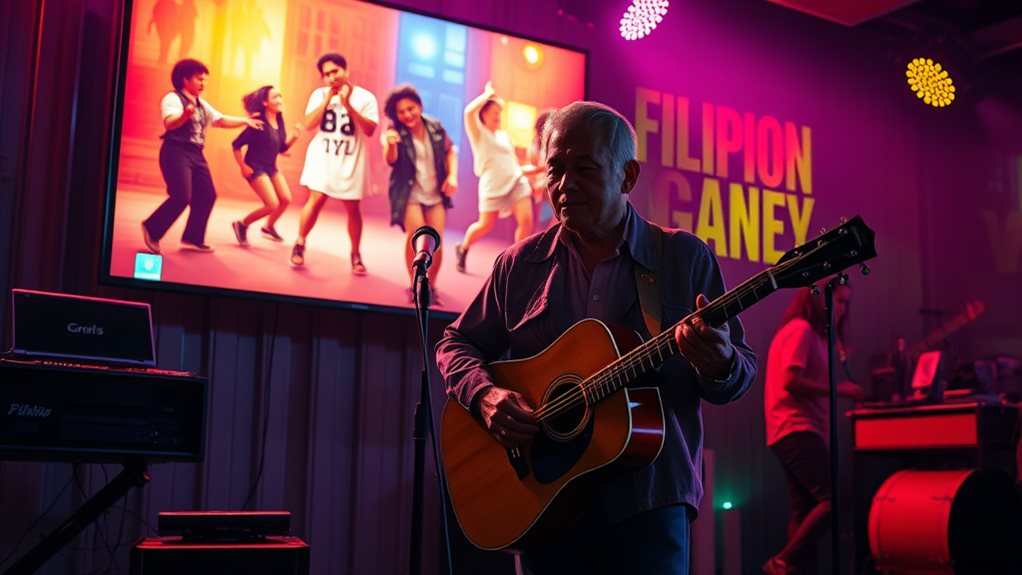
Rising from the late 1980s, hip hop's presence in your music landscape has grown into a formidable genre within Original Pilipino Music (OPM), each artist weaving American hip hop culture with local languages, slang, and cultural references to forge a distinctive sound that speaks to you and your peers. This integration not only brings a global beat into your local scene but also provides a platform to discuss social issues and national identity through lyrics. The underground hip hop scene has nurtured independent artists, leading to the emergence of various sub-genres like Pinoy rap and trap music. Notable Filipino hip hop groups and artists, such as Francis M., Gloc-9, and Abra, have gained popularity by blending these elements, ensuring their music resonates deeply within Filipino communities. Platforms like YouTube and social media have further amplified their reach and direct engagement with fans.
| Artist/Group | Notable Tracks | Themes Addressed |
|---|---|---|
| Francis M. | "Wake Me Up", "Sa South" | Personal struggles, social issues |
| Gloc-9 | "Anak Kong Probinsya", "Lock-up" | National identity, local culture |
| Abra | "I Love You", "Para sa Anong Buwan" | Relationships, cultural happenings |
Protest Music Role
From the late 1980s onward, hip hop's influence on OPM brought global beats into the local scene, blending rhythms with cultural identities and social issues.
Protest music played a pivotal role during the martial law era, with artists like Freddie Aguilar using their songs to critique societal injustices and inspire activism. Songs such as "Bayan Ko" became anthems of the People Power revolution in 1986, reflecting the national desire for freedom and democracy.
- Artists echoed the sentiments of the marginalized, addressing political and social struggles.
- "Bayan Ko" embodied the spirit of resilience against oppression.
- Contemporary OPM continues to carry the torch, engaging with themes of poverty and human rights.
- Festivals like "Himig Handog" amplify protest songs, underscoring music's power as a social force.
How Has the Evolution of OPM Influenced Modern Interpretations of Bahay Na Bato Design?
The evolution of OPM has significantly influenced modern interpretations of Bahay Na Bato design. By blending traditional elements with contemporary aesthetics, architects now create spaces that honor heritage while embracing innovation. This fusion results in a modern bahay na bato design reimagined for today, creating functional homes that reflect cultural identity and progress.
Cultural Fusion Trend

Incorporating Spanish and indigenous musical elements, the cultural fusion trend in OPM lays a foundation for modern Filipino pop music, blending traditional sounds with global genres like rock, R&B, and hip hop, and evolving further with each new influx of diverse influences. This trend started with the integration of Spanish and indigenous musical elements in kundiman, which became a cornerstone for what later developed into Philippine pop. During the 1970s and 1980s, influences from American rock, R&B, and disco were added, bridging the gap between indigenous aesthetics and Western music. Artists like Aegis exemplify this fusion by using traditional Filipino vocal techniques in modern power ballad styles, continuing the trend into the contemporary era. The introduction of Pinoy rock and hip hop in the 1990s and 2000s further diversified Philippine pop, integrating local cultural identity with global trends. Recently, independent acts such as Ben&Ben and IV of Spades have shown a renewed focus on cultural fusion by combining folk songs with modern pop and rock elements, signaling an ongoing evolution in the cultural landscape of OPM.
| Era | Influences | Artists |
|---|---|---|
| 1970s-80s | American rock, R&B | Bobi Evangelista, Freddie Aguilar |
| 1990s-2000s | Pinoy rock, hip hop | Bamboo, Barney Raymundo |
| 2010s | Folk, modern pop | Ben&Ben, IV of Spades |
Questions and Answers
Is Kundiman a Contemporary Music?
Kundiman, with its lyrical characteristics and emotional expression, isn't solely contemporary but evolves through modern interpretations, maintaining cultural significance in today's OPM.
How Has Music Evolved in the Philippines?
Music in the Philippines evolves through blending traditional instruments with cultural fusion, featuring dynamic music festivals and shifting lyrical themes that resonate with contemporary society's personal and social issues.
What Is the History of OPM Music?
You uncover the history of OPM music by exploring its roots in Filipino Identity, Musical Heritage, Cultural Expression, and Artistic Innovation, blending Western influences with traditional sounds to reflect societal changes.
Is Kundiman Spanish Influenced?
Kundiman origins blend indigenous Filipino traditions with Spanish heritage, influencing musical characteristics like minor keys and lyrical themes, enhancing cultural significance through romantic expressions.